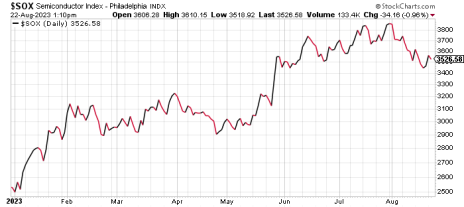There’s no denying that 2023 has been a year marked with uncertainty on the financial market front. With several major sectors either showing losses for the year to date or barely changed from last year, for many it’s starting to feel like another “lost year” for equities. Just not if you’ve been invested in semiconductor stocks. More on those in a minute.
Underscoring the trendless action of the broad market so far this year, consider that as of late August, the NYSE Composite Index is almost unchanged from its closing value of December 31, 2022 (up 3%) and a mere 8% higher than it was in December of 2020.
Indeed, for investors with no exposure to the few outperforming sectors, the year to date has probably felt like treading water—staying afloat but going nowhere.
[text_ad]
One of those outperforming sectors is the tech sector, which has been a bright star in an otherwise dull environment (the Nasdaq Composite Index is up 30% YTD). And it’s precisely because the techs have outperformed that investors should remain optimistic about the intermediate-term (six-to-12 month) outlook.
Among the biggest standouts in the overall tech sector are the leading semiconductor stocks, which has resulted in the PHLX Semiconductor Index (SOX) being up roughly 40% YTD. This isn’t just a meaningless statistic, however, and has special significance for all investors in view of SOX’s history as a leading indicator for the broad-based S&P 500 Index.
Case in point: Since 2000, SOX has led the S&P either higher or lower—with a lead time ranging from a few weeks to up to six months—in 14 of the last 23 years. In the years where SOX didn’t exhibit a leading tendency, the semiconductor index was coincident with the S&P and basically traveled in the same direction, thereby confirming the overall market trend.
Remarkably, in only one of the last 23 years (in 2010) did a divergent signal in SOX fail to serve as a leading indicator for the broad market. The takeaway here is that whenever SOX has given a leading signal for the S&P in the last two decades, the equity broad market has followed SOX’s lead almost every time.
With that in mind, it’s worth mentioning that once again semiconductor stocks have been making waves and have been in a position of relative strength versus the S&P the entire year so far. Based on historical precedent, this has a potentially bullish implication for the broad market in the coming months (though it may take a while for the market’s lagging stock sectors to finish chewing their way through last year’s overhead supply and finally catch up with SOX).
Among the strongest of the semiconductor stocks that investors should paying close attention to, there are more than a few that have built up a good head of steam and should further benefit from any broad market improvement going forward—as well as from fundamental trends favorable to the chip industry. Below are three such standouts.
3 Semiconductor Stocks with Momentum
Applied Materials (AMAT) provides tools and fabrication equipment for the semiconductor, flat panel display and solar photovoltaic (PV) industries and has developed the breakthrough technology to help its memory customers manufacture and scale these cutting-edge 3D NAND memory chips. As its customers demand more powerful microchips, new materials technology is required, which is Applied’s specialty. Additionally, the company has increasing exposure to the red-hot automotive, Internet of Things (IoT) and virtual reality spaces. The company’s recent quarterly earnings report featured healthy top- and bottom-line beats, and the stock subsequently broke out of a multi-month holding pattern as Wall Street comes around to recognize that Applied’s exposure to automotive, IoT and communications is likely to give it stability against a potentially weak economic environment. Analysts, moreover, anticipate a broad recovery in demand for wafer fabrication equipment (due in part to the U.S. CHIPS and Science Act), which should further benefit Applied.
Lam Research (LRCX) supplies wafer fabrication and etching and deposition equipment critical for making advanced logic chips and NAND flash chips to some of the world’s biggest chip companies, with major exposure to mega-growth trends in AI and 5G communications. Despite an oversupply of memory chips (used especially for smartphones that are seeing lower demand right now), industry experts see a beneficial broad-based recovery in wafer fabrication equipment demand in the coming years. Indeed, the main driver for Lam is the increasing number chip fab plants being planned around the world in response to pandemic-era semiconductor shortages (primarily in the automotive industry), which aren’t expected to ease until next year. Lam is further expected to soon launch a raft of new products that should boost sales, and the company’s installed base is experiencing impressive growth from customers’ technology upgrades (up 40% from the last downturn in the chip industry), a trend it sees benefiting its parts and services business. On the shareholder returns front, Lam is tracking towards its long-term plan of giving back 75% to 100% of free cash flow.
Synopsys (SNPS) is a leading provider of chip engineering design automation (EDA) software and simulation tools. It offers not only the design tools critical for manufacturers of silicon chips, but also provides simulators that assist in the design of the logic for chips and computer systems, as well as the industry’s fastest emulation system, the ZeBu EP1, which accelerates the hardware and software verification for system-on-a-chip (SoC) designs. The company has lately been expanding its offerings—and the stock has benefited from it—including a recent unveiling of a series of new artificial intelligence (AI)-powered tools for testing and designing semiconductors. Synopsys’ exposure to powerful trends in electric vehicles and AI-related solutions adaptions, plus China’s resurgence as a chip manufacturer, have prompted some major Wall Street institutions and analysts to upgrade SNPS (one of many reasons for the stock’s strength).
[author_ad]


